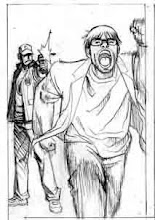The literary movement that is referred to as Beat sprung from a generation that sought something that wasn't being sold to the general populace, a group of "disaffiliated young people coming of age into a Cold War world without any spiritual values they could honor." Caught up in a time where capitalism was coming on strong at the American people, a group of writers went searching for a life with meaning. Spirituality, sexuality, naturalism, and a derangement of the senses were what these pioneers of the soul were in search of.
This Beat Generation was comprised of two separate factions; the New York School and the San Francisco Renaissance which, despite being on either ends of the country, had a common bond. Although there was this strong unifying purpose, a rebellion against the oppression of American culture post World War II, there were also major differences in approach, thought, and beliefs.
The San Francisco Renaissance really set the scene for poetry to explode as it would after the Six Gallery Reading where Allen Ginsberg would debut his epic and Beat defining poem 'Howl'. In the years before Ginsberg and his fellow New York Beats would make it out to the West Coast, poets like Kenneth Rexroth were building a literary scene there. As surrealist poet Philip Lamantia described it, the San Francisco Renaissance, "an expression Kenneth Rexroth first used in 1946", was an "extraordinary convergence of poets, painters, ex-conscientious objectors, and radical anarchists -- rebels of all stripes" and that "Kenneth Rexroth was the central figure".
The Beats of the New York School, comprised of Allen Ginsberg, William S. Burroughs, and Jack Kerouac, were all academics living in New York City. Ginsberg and Kerouac, both disillusioned Columbia students, began hanging out with the slightly older Harvard educated Burroughs, who was out and about among the junkies, criminals and underworld of New York City. They met at various apartments, drank, experimented with drugs, and associated with known criminals. They seemed to be self-destructive and seeking out some sort of "real" life as compared to the capitalist one that was being sold to the American people at the time.
Overall, I see the San Francisco Renaissance doing all the work in the cultivating of a scene so as to support a new crop of poets, and the New York Beats as the marketable characters that are "sacrificed" to the masses so that the scene can expand beyond the small circle of writers. Although there seems to be a fair amount of resentment from the West Coast of being lumped into the Bat Generation label, I imagine that a lot of the work that people see today wouldn't be as widely read if not for the East Coast writers erupting into glorious fame and infamy.
There's something about New York City that one has to survive, and in that it seems to make a person a bit mad, but also a bit more of a survivor and worldly person. The West Coast writers all stayed mostly on the West Coast, where as the New Yorkers all spread out from NYC to San Francisco to Berkley to Mexico to Tangiers, etc.
The San Francisco poets all seemed to be living where and how they wanted, which I like to imagine as the modern equivalent of pioneers moving out to the Wild West to make a new life for themselves. The East Coast seems to be somewhere you escape from, and the West Coast where you escape to.
Subscribe to:
Post Comments (Atom)

No comments:
Post a Comment